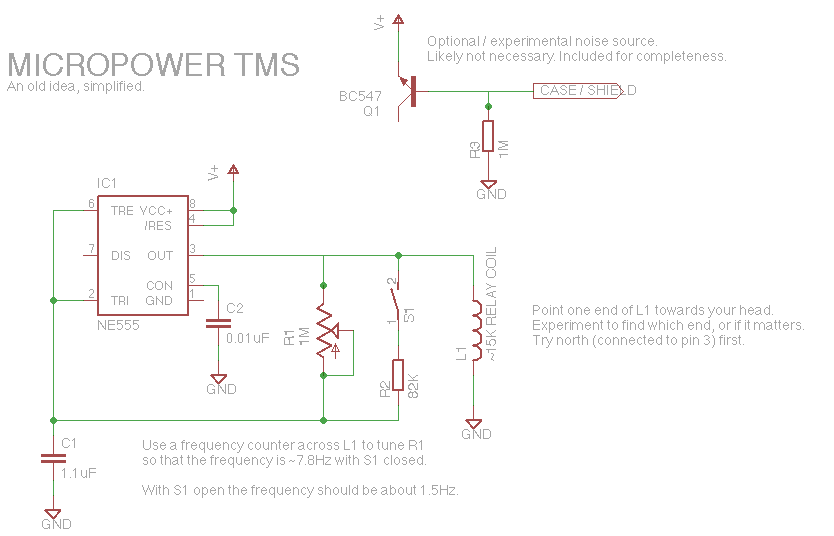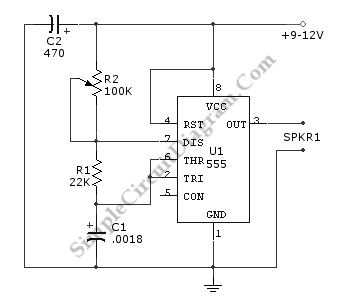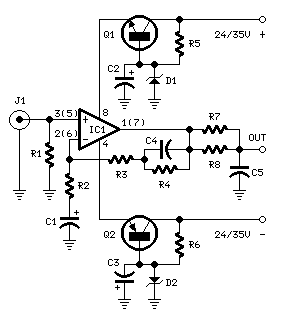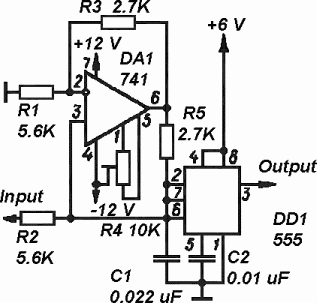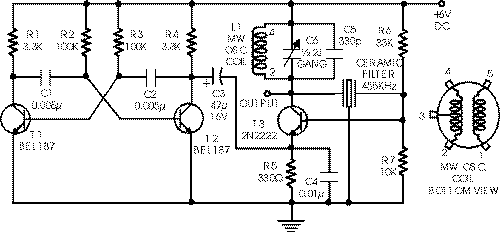
Simple microphone preamplifier
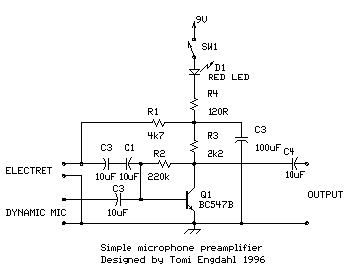
This is a simple microphone preamplifier circuit which you can use between your microphone and stereo amplifier. This circuit amplifier microphone suitable for use with normal home stereo amplifier line/CD/aux/tape inputs. This mic preamp can take both dynamic and electret microphone inputs (preamplifier provides power for electret microphone elements). The idea of this circuit is to keep the design as simple as possible to be easy to build. That was the goal when a simple external microphone preamplifier was needed for a mixer. The performance of the circuit is nothing superior but can be used with many not so serious projects.
Additional Detailed Content: The microphone preamplifier circuit is designed to function as an intermediary device, amplifying the weak signal from the microphone before it reaches the stereo amplifier. The circuit is compatible with a range of inputs, including line, CD, aux, and tape, making it versatile enough to be used with most home stereo systems.
The preamplifier is designed to accept inputs from both dynamic and electret microphones, with the circuit providing the necessary power for the electret microphone elements. This feature expands the range of microphones that can be used with the preamplifier, increasing its utility.
The design philosophy behind this circuit is simplicity. The aim is to make it easy enough to be constructed even by those with a basic understanding of electronics. This was particularly important when the circuit was initially designed to function as an external microphone preamplifier for a mixer.
Although the performance of the circuit may not be superior to more complex designs, it is more than adequate for a range of applications that do not require high-end performance. This makes it a suitable choice for hobbyist projects or for those who are just starting out in electronics and wish to gain practical experience with building and using circuits.
In summary, this microphone preamplifier circuit is a versatile, easy-to-build solution that can be used with a variety of microphones and stereo systems. Its performance is adequate for many applications, making it a practical choice for a wide range of users.This is a simple microphone preamplifer circuit which you can use between your microphone and stereo amplifier. This circuit amplifier microphone suitable for use with normal home stereo amplifier line/CD/aux/tape inputs.
This mic preamp can take both dynamic and electret microphone inputs (preamplifer provides power foe electret microphone elements). The idea of this circuit is to keep the design as simple as possible to be easy to build. That was my goal when I needed a simple external microphone preamplifer for my mixer. The performance of the circuit is nothing superior but can be used with many not so serious projects.
🔗 External reference
Additional Detailed Content: The microphone preamplifier circuit is designed to function as an intermediary device, amplifying the weak signal from the microphone before it reaches the stereo amplifier. The circuit is compatible with a range of inputs, including line, CD, aux, and tape, making it versatile enough to be used with most home stereo systems.
The preamplifier is designed to accept inputs from both dynamic and electret microphones, with the circuit providing the necessary power for the electret microphone elements. This feature expands the range of microphones that can be used with the preamplifier, increasing its utility.
The design philosophy behind this circuit is simplicity. The aim is to make it easy enough to be constructed even by those with a basic understanding of electronics. This was particularly important when the circuit was initially designed to function as an external microphone preamplifier for a mixer.
Although the performance of the circuit may not be superior to more complex designs, it is more than adequate for a range of applications that do not require high-end performance. This makes it a suitable choice for hobbyist projects or for those who are just starting out in electronics and wish to gain practical experience with building and using circuits.
In summary, this microphone preamplifier circuit is a versatile, easy-to-build solution that can be used with a variety of microphones and stereo systems. Its performance is adequate for many applications, making it a practical choice for a wide range of users.This is a simple microphone preamplifer circuit which you can use between your microphone and stereo amplifier. This circuit amplifier microphone suitable for use with normal home stereo amplifier line/CD/aux/tape inputs.
This mic preamp can take both dynamic and electret microphone inputs (preamplifer provides power foe electret microphone elements). The idea of this circuit is to keep the design as simple as possible to be easy to build. That was my goal when I needed a simple external microphone preamplifer for my mixer. The performance of the circuit is nothing superior but can be used with many not so serious projects.
🔗 External reference
